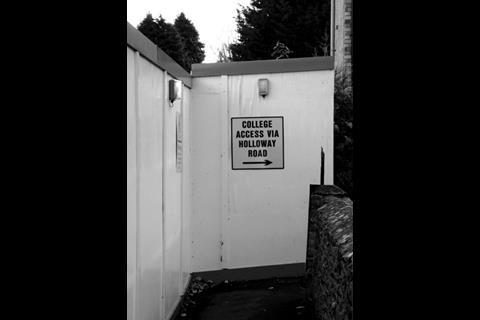The full scale of the Learning and Skills Council funding fiasco is only now becoming clear, as many colleges face up to a long and dismal future in temporary accommodation. Sarah Richardson reveals the full story
When Building first visited Brooklands college in Surrey back in April, the principal, Colin Staff, described its predicament as “abysmal”. Walking around the dilapidated Ashford campus, he pointed out the ivy destroying its Victorian red brick frontage, and gestured angrily at the leaking windows that characterised the bleak sixties building that lay behind it. Wryly, he explained that although the students found the £80,000-a-month temporary huts, which were the newest addition to his teaching space, to be an improvement to the rest of the site, they were “hardly a long-term solution”.
Staff, along with the principals of 143 other further education (FE) colleges in England, had just found out that his plans for his estate’s future were on the brink of disaster. This was thanks to the ineptitude of the Learning and Skills Council (LSC), the quango responsible for delivering a £5bn upgrade programme. After months of delays, the LSC had finally admitted the schemes were on hold – because it had overspent its budget by more than 150%, and had no money to carry on. The colleges, and their supply chains, were left furiously lobbying the government for cash to continue with projects that had been approved by the LSC and were, in some cases, already under way.
Just 14 colleges were awarded money to progress – and Brooklands was not one of them. Now, eight months later, the college finds itself in an even worse position than Staff could have imagined. Crippled by £11.5m of costs for work already done, the college has been declared technically insolvent. Its Ashford campus is expected to close next July and, faced with condensing two sites into one, the college has announced it will stop offering A-level courses from September. This has left students who started their studies this year fighting for places at nearby colleges. Staff, meanwhile, has been forced to resign amid mounting protests from parents, students and teachers.
For Brooklands, and other colleges up and down the country, the full toll of the LSC debacle is only now starting to emerge. Across England, teachers and students are facing up to the reality of life in temporary or decrepit buildings. Construction firms, resigned to the loss of billions of pounds of work, are counting the cost in redundancies. Colleges have been looking at alternative ways of getting schemes built, but as we reveal, only a handful of institutions are likely to be able to restart scaled-back programmes. And these are fighting a series of obstacles that must be overcome if work is to go ahead.
The state we’re in
When the LSC officially put its Building Colleges for the Future programme on ice last March, 65 projects were working up designs in order to pass the first hurdle of the quango’s approval process, while 79 had proceeded to detailed design. Some, with the LSC’s encouragement, had even started site works. But with no money left, the hopes of all of these rested on an extra £300m announced in the Budget after the fiasco came to light. The LSC invited colleges who were “shovel ready” to bid, and received about 90 viable applications as opposed to the 20-odd it expected. Of these, 13 were chosen to receive funds provided they scaled back projects – and a 14th, Skelmersdale in Lancashire (see below), was later added. The rest were told there would be no more money until 2011 at the earliest.
The first response of most colleges who missed out was to challenge the decision. It is understood that, when the decision was announced on 26 June, the LSC website crashed under the weight of freedom of information requests. Part of the anger was because LSC officials did not visit any of the college sites when making their decision.
Many believed their schemes were judged unfairly. One was Abingdon and Witney college in Oxfordshire. The college received approval in principle for its programme in March 2008, and with the encouragement of the LSC transferred students from three of its oldest buildings into temporary accommodation. It had also hired contractor Leadbitter to start stripping out structures ready for demolition. There was no doubt it was “shovel ready” but, ironically, the college lost out in the final funding scramble because its temporary accommodation – which was costing £40,000 a month – was safe and reasonably decent.
Sue Webb, Witney’s head of capital projects, says for a while colleges were talking about clubbing together to mount a legal challenge against the LSC. But in the event, this came to nothing. “It would have been individually too costly, and most have gone away and looked instead at what they can do in a positive fashion. The most important thing is we do the best we can for our learners.”
But those colleges could not afford to keep construction supply chains on board while they considered their next move – especially as many had still been paying firms during the LSC delays. Witney stood down its entire team apart from two consultants, Robinson Low Francis and Turner & Townsend. It had an immediate effect on those firms involved. Architect Dyer, which was working on nine LSC schemes, had to make more than 30 redundancies.
Crippled by £11.5m of costs for work already done, Brooklands college has been declared technically insolvent
The story is the same almost everywhere you look. One architect, which was working on 10 projects, was given the go-ahead on only one. The practice laid off more than one in four of its staff. A source there says the situation was exacerbated because the LSC had told firms that made it onto its architects’ framework to staff up ready for a glut of work. In all, it is estimated up to 40,000 jobs in the sector may have been lost.
In fact, the LSC debacle dealt the sector a double blow. Many of the further education colleges that were due to upgrade would have included enhanced provision for training workers – like Brooklands, whose plans included a £3m construction centre. Even worse, the colleges to lose out included the National Construction College at Bircham Newton in Norfolk, which had to abandon its £26m development programme.
Finding a way forward
The state of many colleges, however, meant they could not give up on improvement work. At Witney, Webb still has the drawings of the abandoned scheme on the walls of her office. “I won’t take them down until I have new plans to replace them.” A visit to the campus makes it clear why. Instead of the iconic foyer envisaged, the cluster of buildings is reached by a five-minute walk through an alleyway of site hoardings. The campus is dominated by the three-storey pile of temporary buildings into which students were decanted a year ago. Although the buildings are, as at Brooklands, better than past facilities – having the capacity to wire in whiteboards, for example – they are hardly ideal. “It’s always either much too hot or much too cold,” says Jo, a nursing student.
There is no option to send students back into their former classrooms, as the start of preliminary demolition made them unusable. Webb says: “As a minimum we will have to demolish most of the vacated buildings as they are not safe, and it would cost almost as much now to refurbish and bring them up to current building legislation than to rebuild.”
Most colleges were to receive roughly 85% of funding from the LSC, making up the remainder themselves using bank loans. This means those colleges that are trying to go ahead have to scale back plans dramatically.
Witney is now envisaging a £14.5m project, which would contain roughly half the amount of new build of the original, with some refurbishment. The three-storey frontispiece building is retained, but the two-storey structure behind will be gone.
The temporary accommodation will stay for the foreseeable future – Webb is looking into buying the cabins outright, because she estimates it could be 10 years before the college can do without them. Sustainability will also suffer – the college, like all progressing through the LSC programme, was encouraged to reach BREEAM “excellent” standard, and was going to install a biomass boiler. This now looks unlikely. A report by the Association of Colleges circulated to those who missed out on funding recommends “ambitions for BREEAM ‘excellent’ status should be removed for the time being”.
The question of funding
Even getting this far with its plans has been a struggle for Witney financially. Webb estimates that because of cost constraints, “no more than 20 or 30 colleges” will be in a position to progress with their schemes. This is partly because colleges failed to recoup much of the money spent before schemes were put on hold. They were allowed to claim up to £1m in costs from the LSC. Witney received just £870,000 of the £4m it spent.
As a minimum we will have to demolish most of the empty buildings as they are not safe, and it would cost more now to bring them up to legislation than to rebuild
Sue Webb, Abingdon and Witney College
For some colleges, like the now-insolvent Brooklands, the burden of money already spent has been enough to curtail schemes for good. Those who do have some cash still cannot justify spending money on a large consulting team. So, firms revising schemes are often doing so for nothing, on the promise of future work. This is the case at Witney. “We’ve asked our service engineers and architects to review plans and tell us what the next phase of work could be. Any member of the design team could potentially then be employed on a daily rate,” says Webb. She is also trying to save money by doing some of the work in house – her manager of capital projects can use Autocad, and has put together layouts for three floors.
Finding the cash for the projects is a major headache. Without the apparent financial security that was offered by the LSC grants, colleges are struggling to attract bank loans. In any case, the weak balance sheets of most colleges – who rely on grant funding for their income – means it would be a huge risk to borrow the whole amount.
So colleges are trying to come up with different sources of funding. Those in deprived areas, particularly in the North, are chasing regeneration funding; options for others include regional funding pots. They are also trying to find areas of sponsorship – Witney, for example, is securing sponsorship of its hairdressing equipment, putting the money saved towards building work.
There is also an outside possibility of some money from the LSC. Of the earmarked spending between 2011 and 2013, £200m has still to be allocated. The money could be allocated earlier, with the LSC considering offering colleges a letter of intent stating the amount they will receive, which may help them to secure bank loans.
Other hurdles
Even if money is found, the path to resuming building work is far from smooth. Ironically, one of the major hurdles is that colleges still have to submit plans to the LSC for approval, even if the LSC is not contributing any money. This is because the body gives colleges the bulk of their revenue funding and so has a deciding vote in decisions affecting learners. Webb says that Witney, which wants to have its project on site next summer, has factored in time for delays as a result. “We have put contingency plans in place to allow for delays in any future approvals process,” she says. She says the LSC has told the college its involvement will be “lighter touch”; however, she points out that the splitting of the quango into two smaller bodies – a move that had been scheduled before the crisis and which is taking place next March – could well add further delays.
Another problem for both colleges and their supply chains is that the dramatic scaling back of schemes means new projects may not be classed as the same scheme for planning or tendering purposes. This could put projects back further, and means some supply chains will have to rebid. Bob Rendell, chief executive of Leadbitter, says he expects that Witney will have to go back to market. “It’s frustrating on a number of different levels,” he says.
The retendering process and the need to scale back schemes does offer a silver lining for the industry in one sense – it will open up opportunities to other firms. Curtins Consulting, which was involved in five of the LSC schemes when the programme was put on hold, is targeting colleges that may be looking to self-fund schemes in the hope of work. It advertised at the Association of Colleges annual conference in November, and one college has already requested a meeting about the company’s services.
It is, however, scant consolation for the heartache caused by the programme – and for that still in store. As Webb points out, while some colleges may have been over-ambitious in their original programmes, there are others for whom refurbishment simply will not stand the test of time. “Our oldest building is 106 years old,” she says. “We’ll need to rebuild eventually, even if we refurbish now, and long-term I don’t entirely see that as value for money for the sector as a whole.”
A rare good luck story
Skelmersdale and Ormskirk college missed out on the 13 funding packages announced in June. The RMJM project was at RIBA design stage E and had appointed BAM as contractor, but was still unsuccessful. But the LSC announced two months later that the scheme could go ahead.
The LSC said it committed to part-fund the £42.8m project in 2008, after Skelmersdale merged with Newcastle college. This does not explain why it had to go through the prioritisation exercise; however, the project team had no complaints.
Chris Fennell, a director at consultant Curtins, says: “The college was proactive. We had meetings while it was touch and go, looking at savings.” RMJM had reallocated resources to other projects and so had to regroup its team. BAM is expected to start on site in February.
The scheme, which involves 13,000m2 of new build, has been largely protected from cuts, saving about £2m through small modifications.
Paul Rodgers, RMJM director, says: “We’ve retained the scale and architectural quality.”
































2 Readers' comments